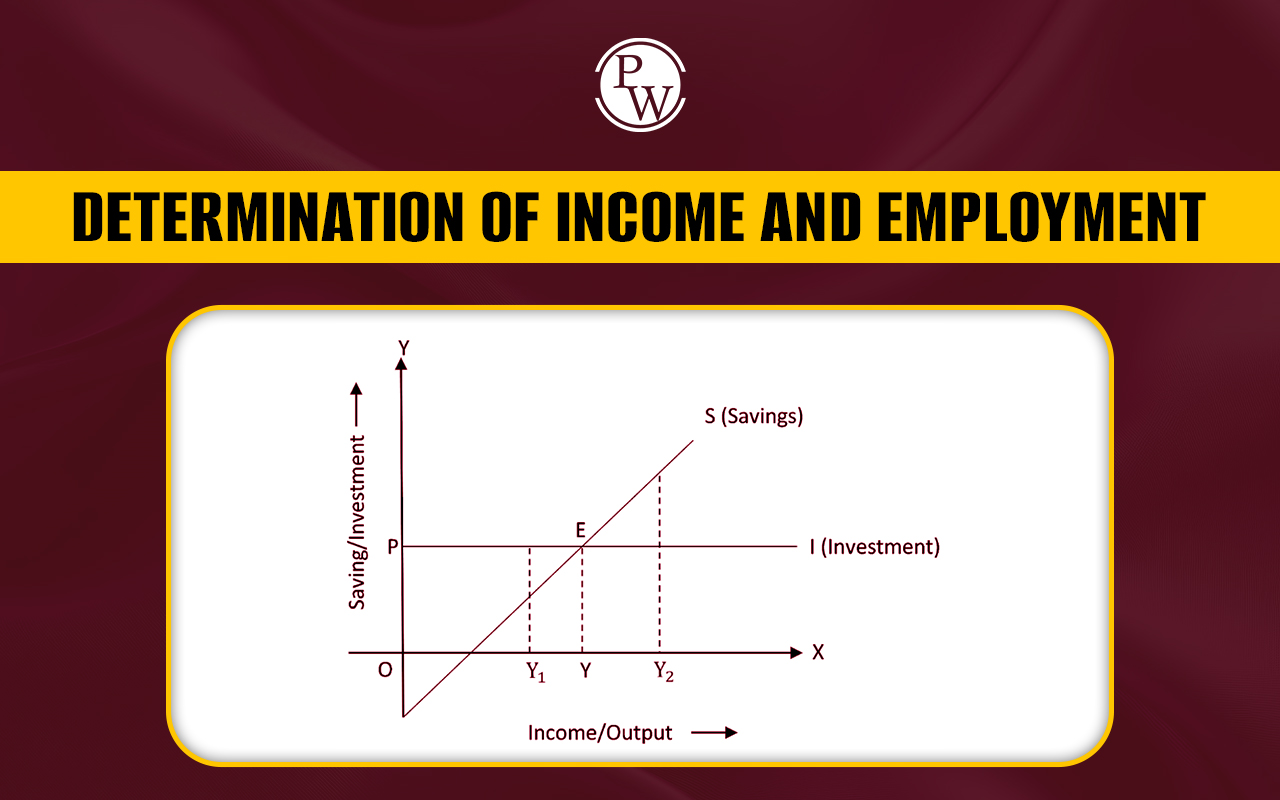

The determination of income and employment is central to understanding how economies function, grow, and fluctuate. It revolves around the concepts of aggregate demand (AD) and aggregate supply (AS) and how these factors influence the total level of economic activity. Economists, particularly John Maynard Keynes, have significantly shaped our understanding of this topic.
The Keynesian Framework
In the Keynesian model, the determination of income and employment is driven primarily by aggregate demand. Keynes challenged the classical view that economies are self-regulating and always tend towards full employment. Rather, he maintained that, as a result of inadequate aggregate demand, economies may endure protracted periods of unemployment. In this context, the role of government intervention becomes critical in boosting demand to ensure full employment.Components of Aggregate Demand
Aggregate demand is the total demand for goods and services in an economy at a given time and price level. It plays a key role in determining the level of income and employment. The higher the aggregate demand, the more goods and services businesses are likely to produce, leading to increased employment opportunities and income generation. Aggregate demand is determined by several components, including:Consumption (C)
This is the total spending by households on goods and services. Consumption is influenced by income levels. As income rises, consumption also increases, although not proportionately.Investment (I)
This refers to the spending by businesses on capital goods like machinery, equipment, and buildings. It also includes changes in inventories. Investment is often volatile and is influenced by factors such as interest rates, business expectations, and technological advancements.Government Spending (G)
This is the total expenditure by the government on goods and services. It includes spending on infrastructure, defense, education, and health services. Government spending is an important tool for influencing aggregate demand, especially in times of economic downturn.Net Exports (X - M)
This is the difference between a country’s exports (X) and its imports (M). When a country exports more than it imports, it has a positive net export, which contributes to aggregate demand. Conversely, a negative net export (more imports than exports) reduces aggregate demand. The sum of these four components (C + I + G + (X - M)) gives us the total aggregate demand in the economy. When aggregate demand is strong, businesses produce more, leading to higher income and employment levels.
The Role of Aggregate Supply
While aggregate demand plays a crucial role in determining income and employment, aggregate supply (AS) also has a significant impact. Aggregate supply refers to the total output of goods and services that firms in an economy are willing and able to produce at a given price level. In the short run, aggregate supply can be influenced by factors such as wage rates, raw material prices, and technological advancements. In the long run, however, the economy’s productive capacity is determined by factors like the availability of labor, capital, and technological progress. When aggregate demand matches aggregate supply, the economy is in equilibrium, and income and employment are stable. However, if aggregate demand falls short of aggregate supply, it can lead to unemployment and a reduction in income levels. Conversely, if aggregate demand exceeds aggregate supply, it can result in inflationary pressures.Keynesian Theory of Income and Employment
One of the most influential theories in understanding income and employment determination is Keynesian Economics, developed by John Maynard Keynes during the 1930s. Keynes introduced the concept of aggregate demand being the driving force behind income and employment. Keynes argued that during economic recessions, insufficient aggregate demand leads to a reduction in production, which, in turn, leads to higher unemployment. He stressed that governments should actively intervene during economic downturns by increasing public spending or cutting taxes to boost demand. This, according to Keynes, would lead to a multiplier effect, where increased spending leads to further rounds of consumption and investment, thereby increasing employment and income levels. One of Keynes' central ideas was the concept of effective demand, which refers to the demand for goods and services that is backed by the willingness and ability to pay. When effective demand is low, businesses produce less, leading to lower income and employment. Keynes' theories continue to influence government policies worldwide, especially during times of economic crises like the 2008 Global Financial Crisis or the 2020 COVID-19 pandemic.Classical Economic Theory
The Classical Economic Theory, which predates Keynesian Economics, offers a different perspective on the determination of income and employment. Classical economists, such as Adam Smith and David Ricardo, believed in the self-correcting nature of markets. They argued that if there is any deviation from full employment, market forces such as changes in wages and prices will naturally restore the economy to its full potential. In classical theory, aggregate supply plays a more dominant role in determining income and employment levels. Classical economists also believed in Say’s Law, which states that "supply creates its own demand." This implies that production or supply leads to income generation, which in turn generates demand for goods and services. Hence, they argued that unemployment is a temporary phenomenon, and full employment will eventually be achieved through the workings of the free market.The Multiplier Effect
A key concept in the determination of income and employment is the multiplier effect. This concept refers to the idea that an initial increase in spending (for example, through government expenditure) can lead to a greater overall increase in income and employment. For instance, if the government spends money on building a new highway, this creates jobs for construction workers, engineers, and suppliers. The workers and businesses involved in the project then spend their income on goods and services, which further boosts demand in the economy. This cycle continues, leading to a multiplied increase in total income and employment. The size of the multiplier depends on the marginal propensity to consume (MPC), which measures the proportion of additional income that households spend rather than save. A higher MPC leads to a larger multiplier effect, as more money is spent and circulated in the economy.Full Employment and the Output Gap
The state of full employment is reached when all labor resources are being utilized as efficiently as feasible. In other words, there is no cyclical or demand-deficient unemployment. However, this does not mean zero unemployment, as there will always be some level of frictional and structural unemployment. When an economy operates below full employment, it is said to have a negative output gap. This means that actual economic output is less than the economy’s potential output. On the other hand, when an economy operates above full employment, there is a positive output gap, which can lead to inflationary pressures as firms increase prices due to excess demand.Policy Implications
The determination of income and employment has significant policy implications. Governments and central banks use monetary and fiscal policies to influence aggregate demand and stabilize the economy.Monetary Policy
Central banks, such as the Federal Reserve or the European Central Bank, use tools like interest rates and open market operations to influence the level of aggregate demand. Lowering interest rates can stimulate investment and consumption, boosting demand, income, and employment.Fiscal Policy
Governments can use tax and spending policies to directly influence aggregate demand. For example, during a recession, the government can increase spending or cut taxes to boost aggregate demand and reduce unemployment.Real-World Implications
The determination of income and employment has significant real-world implications. In times of economic recession or depression, governments often turn to fiscal and monetary policies to stimulate demand. For example, during the COVID-19 pandemic, several countries around the world, including India, implemented stimulus packages and lowered interest rates to support businesses and households. The determination of income and employment is a dynamic process influenced by both aggregate demand and aggregate supply. While Keynes emphasized the importance of demand in driving employment levels, both demand and supply factors must be considered to understand how economies function. Through careful management of monetary and fiscal policies, governments can help maintain a balance between aggregate demand and aggregate supply, ensuring stable income levels and full employment. Unlock your potential in commerce with PW Commerce Courses! Enroll today to gain in-depth knowledge and skills that will help you excel in your exams and future career. Don’t miss out!| Read Related Topics | |
| Consumer Equilibrium | Forms of the Market |
| Law of Demand | What is Export Trade |
| Cross-Price Elasticity of Demand | International Trade |
Determination of Income and Employment FAQs
What is the Keynesian theory of income and employment determination?
Keynesian theory argues that income and employment are primarily driven by aggregate demand, and government intervention is crucial during economic downturns to boost demand and reduce unemployment.
How does aggregate demand affect income and employment?
When aggregate demand increases, businesses produce more goods and services, leading to higher employment and income levels. Conversely, a decrease in demand can result in unemployment and reduced income.
What are the main components of aggregate demand?
The main components of aggregate demand are consumption (C), investment (I), government spending (G), and net exports (X - M).
What is the multiplier effect in economics?
The multiplier effect refers to the process where an initial increase in spending leads to a larger overall increase in income and employment through multiple rounds of spending in the economy.
What is the difference between Keynesian and Classical theories of employment?
Keynesian theory focuses on government intervention and aggregate demand, while Classical theory emphasizes market self-correction, where aggregate supply plays a dominant role in restoring full employment.
Talk to a counsellorHave doubts? Our support team will be happy to assist you!

Check out these Related Articles
Free Learning Resources
PW Books
Notes (Class 10-12)
PW Study Materials
Notes (Class 6-9)
Ncert Solutions
Govt Exams
Class 6th to 12th Online Courses
Govt Job Exams Courses
UPSC Coaching
Defence Exam Coaching
Gate Exam Coaching
Other Exams
Know about Physics Wallah
Physics Wallah is an Indian edtech platform that provides accessible & comprehensive learning experiences to students from Class 6th to postgraduate level. We also provide extensive NCERT solutions, sample paper, NEET, JEE Mains, BITSAT previous year papers & more such resources to students. Physics Wallah also caters to over 3.5 million registered students and over 78 lakh+ Youtube subscribers with 4.8 rating on its app.
We Stand Out because
We provide students with intensive courses with India’s qualified & experienced faculties & mentors. PW strives to make the learning experience comprehensive and accessible for students of all sections of society. We believe in empowering every single student who couldn't dream of a good career in engineering and medical field earlier.
Our Key Focus Areas
Physics Wallah's main focus is to make the learning experience as economical as possible for all students. With our affordable courses like Lakshya, Udaan and Arjuna and many others, we have been able to provide a platform for lakhs of aspirants. From providing Chemistry, Maths, Physics formula to giving e-books of eminent authors like RD Sharma, RS Aggarwal and Lakhmir Singh, PW focuses on every single student's need for preparation.
What Makes Us Different
Physics Wallah strives to develop a comprehensive pedagogical structure for students, where they get a state-of-the-art learning experience with study material and resources. Apart from catering students preparing for JEE Mains and NEET, PW also provides study material for each state board like Uttar Pradesh, Bihar, and others
Copyright © 2025 Physicswallah Limited All rights reserved.
Get App











